You can still see the scar on Vicky Duniven’s sternum. It barely peeks over the neckline of her shirt—a glint of mangled skin that hints at the remnants of a much larger wound left when her chest was split open to remove a cancerous growth the size of a grapefruit.
Duniven is a quintessentially tragic picture of a health-care system that forces people to choose between keeping their homes or staying alive. She’s been churned through the maniacally expensive gears of American medical care if for no other reason than the universe dealt her a bad hand.
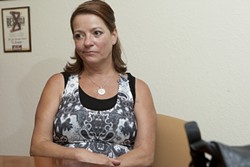
- PHOTO BY STEVE E. MILLER
- ‘I AM THE PEOPLE’ : Vicky Duniven, a cancer survivor who also suffers from myasthenia grabis and lupus, is one of about 6,000 people who depend on medical services CHC provides.
She is very sick and should probably be dead.
In 2000, Duniven was suddenly struck virtually blind by double vision and then diagnosed with a rare neurological disease called myasthenia gravis. She’s been hooked to hospital breathing machines when her lungs stop working, had paralyzed vocal chords, and suffered odd spasms that keep her body from getting the message when her brain says “swallow,” for example.
“It’s a really confusing, crazy disease,” she said.
Duniven estimated her medical bills hit as high as millions of dollars at one point.
“I have a very extreme case of myasthenia gravis,” she said. “It’s almost killed me three times.”
She was hospitalized in French Hospital Medical Center after her initial diagnosis in 2000. Then Duniven was shipped to UCLA to have growths that were endangering her vital arteries removed. Her disease flared up again in 2003, and she spent five months in the hospital. By that point, she was told to apply for disability.
But Duniven is uninsured and now woefully uninsurable because of her disease. She’s a single mom who went into business for herself after getting tired of making 10 bucks an hour. Before her diagnosis, Duniven started work as a private contractor who helped companies complete DMV title transfers. It was a weird job, she admits, but an interesting one. One time, she handled a title transfer on the VW Thing Drew Barrymore drove in the movie 50 First Dates.
After being diagnosed, faced with mounting bills and two kids, she decided to go back to work. Then, in December 2008, when her kids were visiting for the winter holiday, Duniven collapsed at dinner.
“I literally dropped to the floor and could not breathe,” she said.
Duniven had suffered four pulmonary embolisms. She was taken by ambulance to the hospital and later shipped up to Stanford and diagnosed with cancerous thymomas. On top of the myasthenia gravis, she had to go through radiation treatment for her cancer and spent so much time in bed, her muscles atrophied to the point she was unable to move.
“I literally was not expected to live—at all,” she said. “… Bottom line is I couldn’t work anymore. I mean, I couldn’t even wash my hair and brush my teeth.”
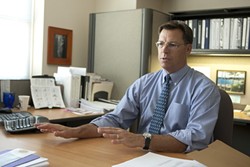
- PHOTO BY STEVE E. MILLER
- GETTING DOWN TO BASICS : Looking for more than $2 million to slash from his budget, County Health Agency Director Jeff Hamm recommended reducing the county’s contract with CHC by $800,000 this fiscal year.
That was in early 2009, and last year, the universe dealt Duniven another blow: lupus.
“And here it is 11 years later, and I got diagnosed with lupus and I’m a cancer survivor,” she said.
But Duniven, with her calm, raspy voice and polite demeanor, is perpetually optimistic. As a fourth-generation Atascadero resident who’s traced her family’s history in SLO County to the 1800s, she remains an almost recklessly active person. She’s an avid horse rider who continues to saddle up despite her illnesses and even managed to break her collar bone while riding. She laughs it off.
“The time I do have here, I would prefer for it to be quality rather than quantity,” she said.
Duniven is also one of about 6,000 patients per year who depend on Community Health Centers of the Central Coast (CHC), a nonprofit corporate network of medical care based out of Nipomo.
CHC is more than 30 years old, the brainchild of Ron Castle, founder and CEO. It began as a small Nipomo clinic with a handful of employees and shoestring budget, but has since grown to 460 employees across 25 clinics in SLO County and northern Santa Barbara County, with a budget that peaked at $58 million last year.
“There really are some great doctors there, and they’re there to serve the people,” Duniven said. “And I am the people.”
As a Federally Qualified Health Center, CHC is reimbursed primarily by federal and state dollars through Medicare and Medi-Cal, along with other smaller funding sources like a contract with SLO County to operate some of its clinics. In SLO County, alone, CHC is responsible for about 90 percent of the local Medi-Cal services.
And things have been good for CHC. Revenues climbed year to year, patient encounters increased, and employees were compensated accordingly.
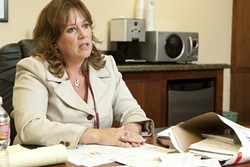
- PHOTO BY STEVE E. MILLER
- HEAR OUR SIDE: Executive Director of the CHC Foundation and Community and Government Relations Officer Kena Burke wanted SLO County supervisors to hear from patients what further cuts could mean for their health care.
Yet, as with most things these days, the good times finally hit a wall. Going into the 2011-12 fiscal year, CHC expects to record its first financial downswing in at least seven years.
At the moment, all eyes seem fixed on SLO County, which has steadily chipped away its contractual funding to the nonprofit in recent years.
This fiscal year, the county is tentatively slated to cut in half its contractual funding to CHC. And in response, CHC is threatening to close its clinics in Cambria and Morro Bay alongside other cuts to services it has historically provided to the county’s poor and ill.
Duniven prides herself on being well-informed. But she—and indeed hundreds of people like her in San Luis Obispo County—has been dragged into a fight between county officials and CHC administrators, ripped apart at the seams in the tug-of-war over her own health care.
Mom and Dad are fighting
At the June 13 Board of Supervisors meeting, CHC administrators came to protest budget cuts, bringing with them a parade of sick people like the twerpy cub scouts out of Mr. Smith Goes to Washington. About a half-dozen people came in protest. Among them were cancer patients, indigent adults, and the mother of a recently diagnosed schizophrenic. They pushed through tears as they made somber pleas to county supervisors to keep their clinics open.
Without CHC, many of the people said, they would be dead.
Simultaneously, CHC has amassed hundreds of postcards from patients detailing their illnesses and begging the county to keep their clinics open.
It was a heartening display that came at the tail end of a political slap fight between supervisors and CHC administrators.
The title fight was between Supervisor Bruce Gibson and CHC Chief Executive Officer Castle. In the one corner was Gibson, armed with CHC’s tax statements and Castle’s salary information. And in the other corner was Castle, who countered that he was being publicly embarrassed in order to deflect the argument from cuts to poor people.
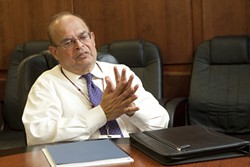
- PHOTO BY STEVE E. MILLER
- MISPLACED BLAME : CHC Chief Financial Officer Bob Lotwala thinks county officials are trying to distract from their own cuts to poor people and shift focus to CHC’s finances.
“You have come before us, and your postcard campaign has promulgated the idea that this board does not care about its required medically indigent care program, and I want you to know that, that is absolutely offensive to me,” Gibson told Castle.
That was followed by a lot of gavel banging, arguing, and Gibson asking for CHC to show how it had reduced its costs to preserve patient care.
“Mr. Castle, I want you to answer this question,” Gibson continued. “If this board doesn’t move its grant amount from $3 million to $4 million, which is what your letter suggests, you’re telling me you’re going to make those clinic closures?”
“I hope that’s not necessary,” Castle responded.
“Ah. You hope it’s not necessary.”
“Not ‘ah.’ I’m always—we’re always looking for ways to be creative. We’ve raised our sliding fee scale; we’re negotiating higher rates. Look, we’re the good guys here. While you were slashing our budget over and over again, we maintained and increased the level of services. Now that our budget is in a problem, I go to the county and I ask for some help and what do I get? Lectures from you and others on our financials.”
“Have you reduced your employment compensation to any member of the CHC staff?”
“That is part of what will be discussed, but frankly that’s none of your business.”
In the months leading to the county’s budget hearings, County Health Agency Director Jeff Hamm had informed CHC that it should expect further cuts to its contract. The argument really boils down to a question of what the county committed to provide, and what’s it’s legally required to provide.
In 1982, changes to California’s Welfare and Institutions Code shifted the responsibility of providing care to medically indigent adults to counties. Through a variety of means, counties obliged, taking on the pool of patients under County Medical Services Program (CMSP). Such patients fall through the cracks of other government-subsidized medical treatment plans. To qualify as CMSP, patients must also meet certain income qualifications to show they’re truly in need of help.
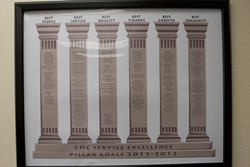
- PHOTO BY STEVE E. MILLER
- PRIORITIES : For the first time in years, CHC is re-prioritizing its finances, chopping some services to SLO County residents.
For a while, SLO County maintained its own CMSP program along with treatment for other patient classes. But by 2003, local services began to change. The county closed its general hospital—a controversial decision that reeks of bad blood even today. And in 2004, county officials decided to shuck responsibility of its medical clinics—a multi-million-dollar drain on the county’s budget—to CHC and begin a five-year contract with the nonprofit for $4.66 million in the first year, with steady increases each year thereafter. The contract peaked in 2007-08 at $5.2 million.
The original deal went far beyond just CMSP patients, which has never been the only population the county served. CHC was provided enough funding to treat a wide swath of patients. It was such a good deal that even before the first five-year contract expired, the county and CHC renewed it.
“They’re the perfect organization to run a clinic system,” said County Health Agency Director Hamm. “It was, in my view, the perfect decision made by the Board of Supervisors at the time.”
Then came the recession. Beginning in 2008, the county began decreasing its contribution to CHC.
Still, Hamm thinks it was a great deal.
“It’s not like we handed the keys to Blue Cross or a big insurance company,” he said.
With the new pool of funding from the county, CHC was finishing fiscal years with large pots of unrestricted net assets: $1.5 million in the first year, followed by $1.9 million the next year, Hamm said.
Yet Hamm has been the one tasked with making the recent cuts. This year, faced with a $2 million general fund reduction to his budget, he informed CHC’s top dogs that the county was going to draw down its contract from $3 million to $2.2 million.
County officials have been financially anorexic over the last four years, leaving no department safe from annual cuts. Yet CHC took a large share of the Health Agency cuts, accounting for about 30 percent of the agency’s total reductions.
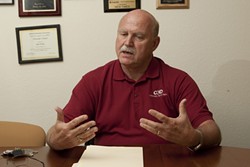
- PHOTO BY STEVE E. MILLER
- TOP DOG : CHC Founder and Ceo Ron Castle’s compensation package has made him a target when it comes to CHC’s spending priorities.
Hamm’s letter also signified for the first time that the county intended to scale its funding to only pay for the CMSP population.County officials argue that CHC was given more money in those first years than the county was legally mandated to provide. CMSP patients only account for about 5 percent of CHC’s patient encounters, and county funding was more than enough for that population in years past. But the contract with CHC to take over clinics has provided miles of legal and semantic hurdles.
In April, CHC fought back. In a letter addressed to county supervisors, Castle informed the county that it would likely close the Cambria and Morro Bay clinics, close the San Luis Obispo radiology department, reduce SLO pharmacy hours by half, reduce Atascadero’s clinic physician services by half, reduce SLO’s specialty and homeless health-care services each by half, and increase the sliding fee scale by 50 percent.
Furthermore, CHC warned that it would not only not accept further cuts, but needed $4 million from the county—$1 million more than the previous year’s funding—to stay solvent.
“To be blunt, CHC can no longer maintain $5.1 million in contracted services with only $2.5 million in funding,” Castle wrote.
On top of the county cuts, CHC got hit this year with a combined $3 million in cuts from the state and CenCal Health.
About two months ago, CHC hired Kena Burke to handle its community government relations and to help set
up a foundation for a new clinic site planned for construction in the coming years. Soon, CHC was lobbying its patients to fill out postcards with their stories and plead to county officials to save CHC services:
“Please don’t close my clinics.”
“I think this is a good and wonderful program and clinic.”
“Please don’t close my clinic; I need it for my health.”
Oddly, in a public maneuver to draw more funding that would save two of its outlying clinics, CHC drew in pleas from all of its patients, many of whom would not be affected by the outlying clinic closures.
When CHC chose which cuts to make, it didn’t look at all its services, but rather chose cuts from what it’s legally obligated to provide the county under the terms of its contract. Patients who filled out postcards didn’t know what cuts were being made or how comparatively small SLO County’s funding is to the entire CHC budget.

- PHOTO BY STEVE E. MILLER
- HELP US : In attempt to dissuade SLO County supervisors from further cuts, CHC lobbied its patients to fill out postcards with personal stories.
It was a ploy that has been quietly criticized as fear mongering and banking on the sympathy factor of sick people to avoid funding reductions.
“It wasn’t fear mongering,” Burke said. “This was an attempt to tell a story of a lot of people who use our services.”
Burke said CHC is going to go back and give its patients better information on the proposed cuts and exactly how much funding the county provides. Still, Burke and other CHC heads say the county broke the promise it made when the contract was first signed.
Though the county isn’t breaking its legal mandate to serve CMSP patients, the change in rhetoric seems to signify
a breaking point in the relationship
with CHC.
Castle told New Times he sees the county as a deadbeat dad—think of it like a fly-by-night-guy who promises to take the kid to the zoo, then goes out for a pack of cigarettes and sends a ratty stuffed elephant by mail.
“If we’d have known that, we would have probably passed on the original contact,” Castle said.
To an outside observer, it was like a marriage of heroin addicts. In the beginning, both CHC and the county were rolling in money and free dope. Now there’s nothing but plastic baggies and lamps smashing against the walls.
Representatives from the Health Agency are still in discussions with CHC reps in the hopes of reaching an agreement to balance the county’s funding reductions while keeping local clinic doors open. But based on early talks, the likely outcome seems to be the county will provide $2.5 million instead of its original $2.2 million proposal, still far short of the $4 CHC wants.
“Literally it’s never been about the money with me,” Castle said. “It’s been about an organization that’s been making health care accessible and affordable for the Central Coast.”
But as CHC and the county square off, it’s all about the money.
Balancing the checkbook
At the same time the county began reducing its contribution to CHC, the nonprofit continued to flourish financially. In the 2008-09 fiscal year, for example, the county reduced its contribution from $5.2 million to $4.9 million, then to $3.65 million in 2009-10. All the while, CHC’s revenues continued to exceed expenses. From 2005 to 2010, CHC revenue increased 165 percent.
Salaries were ballooning, too. In 2009-10—the second year of cuts from the county—Castle took in an 11 percent salary increase, roughly $30,000, to bring his base compensation to $292,816.
In fact, four of CHC’s highest paid employees—Castle, Medical Director John Khan-Variba, Physician Satish Raj, and Chief Financial Officer Bhupendra “Bob” Lotwala—averaged 17 percent salary increases that year, with each person pulling in the neighborhood of $30,000 extra pay, according to CHC tax documents. Base compensation for just those four employees went up $156,244 over the previous year.
One of Gibson’s constituents, in a letter addressed to Castle, wrote, “Shame on you and your team for trying to threaten to close the far out clinics of Cambria and Morro Bay as a way to get the SLO County Supervisors to give you more money to keep your operations growing for you and your highly paid professionals to make more money for yourselves.”
CHC’s prosperity—particularly for its six-figure administrators—has clearly pissed off some county labor officials, particularly as most county employees are foregoing pay increases in order to prevent layoffs.
“It’s known that they became a lot more profitable after that county contract,” one local official said.
Castle’s base compensation went up $90,429, roughly 44.7 percent, between 2005 and 2010, according to the five most recently available CHC tax statements.
Administrators say the tax forms are misleading because they don’t detail accounting quirks like when an employee cashes in paid time off or money layovers across fiscal years. They also affirm that CHC administrators—Castle in particular—don’t make more than people from other similarly sized health organizations. However, no one has argued that CHC revenues and salaries weren’t increasing at the same time the county was cutting.
Hefty compensation for CHC’s upper echelons has helped fuel rumors that company funds go toward lavish overseas trips disguised as team-building exercises. In reality, CHC administrators do take regular international trips—China, Peru, and Costa Rica were some recent destinations—though they pay for the trips out of pocket and use vacation hours for the time off.
“There’s a group here that worked for a long time together and I think I heard that they want to see the seven wonders of the world,” Burke said.
CHC’s latest budget finally proposes pay freezes for most of its staff. For the first time in years, the organization is expecting a decrease in revenue and is adjusting its books accordingly, including layoffs from clinic closures and service reductions.
Yet, while personnel expenditures for CHC physicians are set to decrease by about $410,000 from the previous year (largely due to the clinic closures), administrative support has only been chopped by about $57,500.
CHC officials contend that their books are in order, have stood up to regular audits, and were never scrutinized until the organization finally protested county cuts.
“What is interesting here is the county is the one cutting our funds for the last three or four years and now the focus is on CHC,” Lotwala said.
It doesn’t mean we don’t love you
What really matters, and what seems to get lost in this argument, is that it doesn’t matter how much a guy like Castle makes. It doesn’t matter what the county’s minimum funding obligations are.
It doesn’t matter what was said or what was promised or whether CHC administrators take a collective trip to Antarctica just so they can watch the glaciers move. It doesn’t matter, because as long as poor, sick people continue to have a place where they can get medical care—perhaps the only place they have left—the ends seem more important than the means.
Amid the bitching and fighting and tear jerking, some of the most needy people in the county have become pawns in a larger political chess game.
They’ve been told their clinics will be closed. They’ve been told CHC rewarded its administrators at a time when it should have been skimming from the top.
But for someone like Duniven, it doesn’t seem to matter. She doesn’t really care about the arguing. It’s just a bunch of circulative bantering for her.
“From my perspective as a patient,” she said. “I looked at it as do we have to rally ourselves and go have a bake sale?” she said.
News Editor Colin Rigley can be reached at [email protected].
Comments